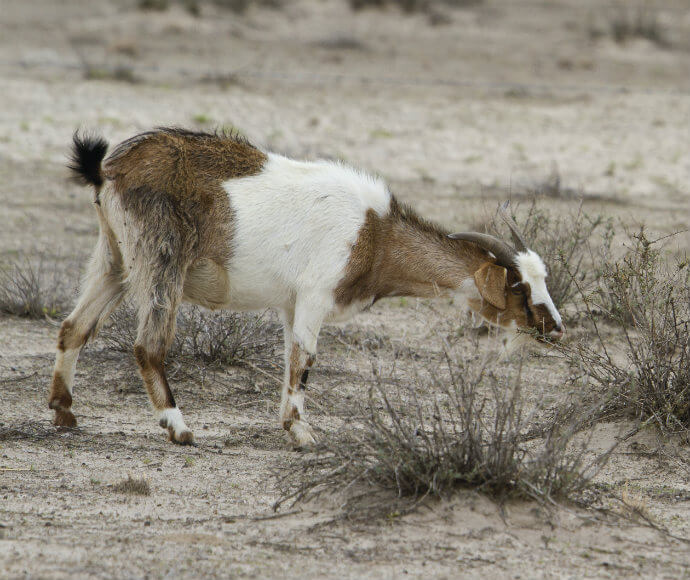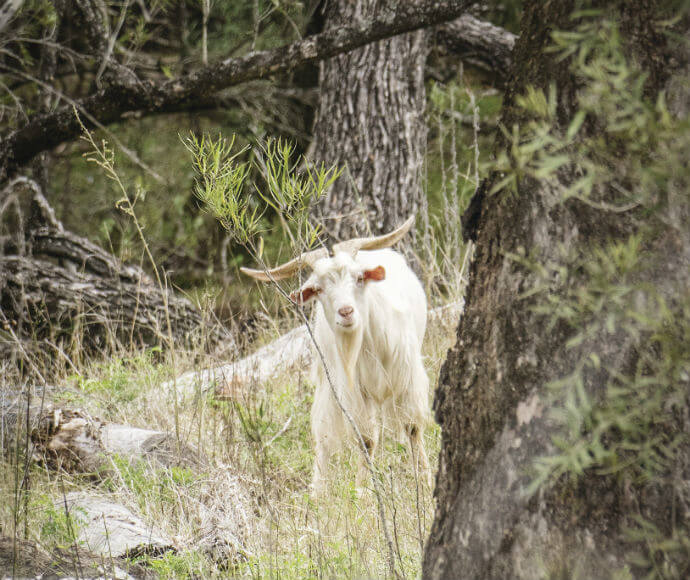What are feral goats?
Goats are not native to Australia. They were introduced to New South Wales as domestic livestock from the time of European settlement, and many more have been imported since then. Wild populations of feral goats have become established by goats that have either escaped or been released from domestic herds on farms. They are present across much of Australia and are particularly prevalent in western New South Wales.

Feral goat causing habitat degradation
Why are they a pest?
Feral goats are rated by the National Parks and Wildlife Service (NPWS) as a high-priority pest issue because they:
- eat native plants – as selective feeders, feral goats can quickly reduce the diversity of plant species by overgrazing and preventing the regeneration of some trees and shrubs and by allowing those plants resistant to grazing to replace original forest
- compete with native animals for food, water and shelter
- cause soil erosion through overgrazing and trampling vegetation ground cover
- can compete with domestic livestock for resources
- can spread disease to native animals and domestic livestock – feral goats are hosts to many sheep diseases and a potential host of foot-and-mouth disease
- damage Aboriginal heritage sites.
Competition and habitat degradation by feral goats has been listed as a key threatening process in New South Wales by the NSW Scientific Committee.
Managing feral goats in our national parks
The successful control of feral goats both within our national parks and on neighbouring properties relies on a cooperative approach between the NPWS, private landholders, other agencies such as Local Land Services and the community.
As feral goats are widespread, management focuses on the reduction of impacts in priority areas. We prioritise management of feral goats for the protection of threatened species through our regional pest management strategies and Saving our Species (SOS) program.

Feral goats destroy native vegetation
Strategies used to reduce and control the numbers of feral goats include the following.
Fencing
NPWS research in western New South Wales has demonstrated that goats rarely travel more than 3.5 km from a water source and are therefore highly dependent on artificial watering points such as tanks and bores. The strategic closure of on-park artificial watering points, and goat-proof fencing on NPWS boundaries near watering points, has reduced immigration into parks from surrounding properties and led to a significant decrease in goat numbers in some key national parks.
Mustering
Feral goats like to gather in herds. In open, flat country, goat herds can be mustered into holding yards with motorbikes and working dogs.
Trapping at water supplies
Traps at watering holes can be an effective method of control. Traps consist of a goat-proof fence surrounding a watering point that is entered through a one-way gate or ramp. Traps must be cleared regularly to avoid stress and starvation in the captured goats.
Shooting
Aerial shooting using helicopters is extremely effective and can result in a rapid and substantial reduction in goat numbers. Ground shooting is labour intensive but can produce good results if control programs are well planned and the effort is maintained.
Report pests
Widespread pest animals should be reported to your Local Land Services.
Sightings of unusual animals should be reported to the Department of Primary Industries and Regional Development via the website or by phoning 1800 680 244.